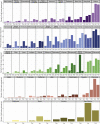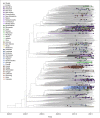Early introductions and transmission of SARS-CoV-2 variant B.1.1.7 in the United States
- PMID: 33891875
- PMCID: PMC8018830
- DOI: 10.1016/j.cell.2021.03.061
Early introductions and transmission of SARS-CoV-2 variant B.1.1.7 in the United States
Abstract
The emergence and spread of SARS-CoV-2 lineage B.1.1.7, first detected in the United Kingdom, has become a global public health concern because of its increased transmissibility. Over 2,500 COVID-19 cases associated with this variant have been detected in the United States (US) since December 2020, but the extent of establishment is relatively unknown. Using travel, genomic, and diagnostic data, we highlight that the primary ports of entry for B.1.1.7 in the US were in New York, California, and Florida. Furthermore, we found evidence for many independent B.1.1.7 establishments starting in early December 2020, followed by interstate spread by the end of the month. Finally, we project that B.1.1.7 will be the dominant lineage in many states by mid- to late March. Thus, genomic surveillance for B.1.1.7 and other variants urgently needs to be enhanced to better inform the public health response.
Keywords: B.1.1.7; SARS-CoV-2; community transmission; epidemiology; flight volumes; genomic surveillance; introductions; lineage; phylogenetics; variant.
Copyright © 2021 Elsevier Inc. All rights reserved.
Conflict of interest statement
Declarations of interests M.J.M., G.K., J.M., J.T.D., M.N., N.B., and C.E.M. work for Tempus Labs. K.S.G. receives research support from Thermo Fisher for the development of assays for the detection and characterization of viruses. The remaining authors declare no competing interests.
Figures










Update of
-
Early introductions and community transmission of SARS-CoV-2 variant B.1.1.7 in the United States.medRxiv [Preprint]. 2021 Mar 11:2021.02.10.21251540. doi: 10.1101/2021.02.10.21251540. medRxiv. 2021. Update in: Cell. 2021 May 13;184(10):2595-2604.e13. doi: 10.1016/j.cell.2021.03.061. PMID: 33594373 Free PMC article. Updated. Preprint.
Comment in
-
Tracking self-performance in the prefrontal cortex: It's layered.Cell. 2021 May 13;184(10):2534-2536. doi: 10.1016/j.cell.2021.04.030. Cell. 2021. PMID: 33989547 Free PMC article.
References
-
- Becker R.A., Wilks A.R., Brownrigg R., Minka T.P., Deckmyn A. The R Project for Statistical Computing; 2018. maps: Draw Geographical Maps. R package version 3.3.0.
-
- Borges V., Sousa C., Menezes L., Gonçalves A.M., Picão M., Almeida J.P., Vieita M., Santos R., Silva A.R., Costa M., et al. Tracking SARS-CoV-2 VOC 202012/01 (lineage B.1.1.7) dissemination in Portugal: insights from nationwide RT-PCR Spike gene drop out data. Euro. Surveill. 2021;26:2100131. - PMC - PubMed
-
- CDC . 2021. US COVID-19 Cases Caused by Variants.https://www.cdc.gov/coronavirus/2019-ncov/transmission/variant-cases.html
-
- CDC . 2021. Genomic Surveillance for SARS-CoV-2.https://www.cdc.gov/coronavirus/2019-ncov/cases-updates/variant-surveill...
-
- Davies N.G., Abbott S., Barnard R.C., Jarvis C.I., Kucharski A.J., Munday J.D., Pearson C.A.B., Russell T.W., Tully D.C., Washburne A.D., et al. CMMID COVID-19 Working Group. COVID-19 Genomics UK (COG-UK) Consortium Estimated transmissibility and impact of SARS-CoV-2 lineage B.1.1.7 in England. Science. 2021;372:eabg3055. - PMC - PubMed
Publication types
MeSH terms
Grants and funding
LinkOut - more resources
Full Text Sources
Other Literature Sources
Medical
Miscellaneous

